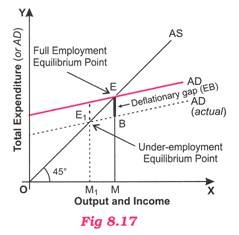Deficient Demand of Full Employment: Meaning, Impact, Deflationary Gap and Reasons (with diagram)!
Meaning:
When in an economy aggregate demand falls short of aggregate supply at full employment’, the demand is said to be a deficient demand, and the difference is called deflationary gap.
Simply put, deficient demand refers to aggregate demand falling short of aggregate supply at full employment level of output. As a result, resources of the economy remain partly unutilised indicating underemployment.
In other words, it means that demand is not sufficient or adequate to eliminate involuntary unemployment. It indicates that there are people who are willing to take up Jobs at the prevailing wage rate but the economy cannot provide jobs to them because current AD falls short of aggregate demand required to reach the level of full employment. Thus, deficient demand is a situation of under-employment equilibrium.
Impact:
ADVERTISEMENTS:
(i) Deficient demand leads to fall in prices which in turn lead to fall in level of income, output and employment
(ii) A persistent fall in deficient demand leads to state of depression in the economy.
Deflationary gap:
In an economy when aggregate demand is less than aggregate supply at full employment, then the deficiency or gap is called deflationary gap. It is the difference between the actual level of aggregate demand and the level of aggregate demand required to establish the full employment equilibrium. It is a measure of amount of deficiency in aggregate demand. Thus, deflationary gap is synonym of deficient demand.
The gap is called deflationary because it leads to deflationary situation (continuous fall in prices). For instance, suppose an economy by utilising all its available resources can produce 10,000 qtls of rice. If the actual aggregate demand for rice is, say, 8,000 qtls, this demand will be termed as deficient demand and the gap of 2,000 qtls as deflationary gap.
ADVERTISEMENTS:
Clearly, here the equilibrium between AD and AS is at a point where aggregate demand is for an amount of output (here 8000 qtls) which is less than full employment level of output (here 10,000 qtls). Keynes called it under-employment equilibrium.
Deflationary gap has been illustrated in Fig. 8.17. Here, point E lying on 45° line is the full employment equilibrium point. This is an ideal situation because aggregate demand represented by EM is equal to ‘aggregate supply at full employment’ represented by OM.
Suppose, the actual demand is for a level of output OM; (E1M1) which is less than full employment level of aggregate supply OM (or EM). The difference between the two, i.e., the actual aggregate demand E1M1 (or OM1) and aggregate supply at full employment EM (or OM) is EB which is a measure of deflationary gap or deficient demand. Mind, E1 is the under-employment equilibrium point.
Reasons:
The reasons of fall or deficiency in demand are obviously fall in the constituents or components of aggregate demand. We have seen in Section 8.4 that main components of aggregate demand are consumption and investment. Thus, the main cause of deficiency in demand is (i) fall in the levels of consumption and investment. In addition other causes of deficient demand are (ii) fall in total supply of money in the country either because of contraction of credit facilities by the banks or fall in supply of currency by the government, (iii) decrease in disposable income due to rise in tax rates and (iv) increase in propensity to save.
ADVERTISEMENTS:
Causes of deficient demand:
Causes are (i) Fall in government expenditure, (ii) Fall in level of Autonomous investment, (iii) Decrease in Marginal Propensity to consume (MFC) and (iv) Fall in Supply.
